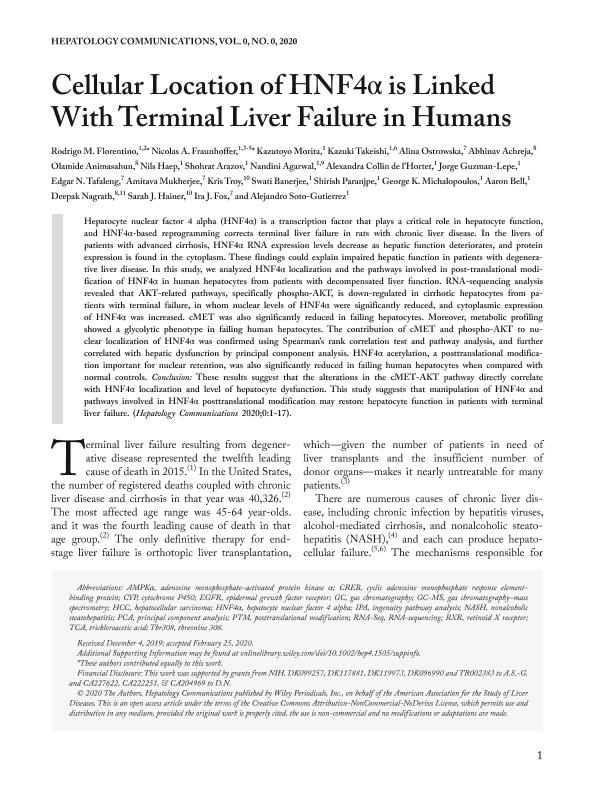Artículo
Cellular Location of HNF4α is Linked With Terminal Liver Failure in Humans
Florentino, Rodrigo M.; Fraunhoffer Navarro, Nicolas Alejandro ; Morita, Kazutoyo; Takeishi, Kazuki; Ostrowska, Alina; Achreja, Abhinav; Animasahun, Olamide; Haep, Nils; Arazov, Shohrat; Agarwal, Nandini; Collin de lHortet, Alexandra; Guzman Lepe, Jorge; Tafaleng, Edgar N.; Mukherjee, Amitava; Troy, Kris; Banerjee, Swati; Paranjpe, Shirish; Michalopoulos, George K.; Bell, Aaron; Nagrath, Deepak; Hainer, Sarah J.; Fox, Ira J.; Soto Gutierrez, Alejandro
; Morita, Kazutoyo; Takeishi, Kazuki; Ostrowska, Alina; Achreja, Abhinav; Animasahun, Olamide; Haep, Nils; Arazov, Shohrat; Agarwal, Nandini; Collin de lHortet, Alexandra; Guzman Lepe, Jorge; Tafaleng, Edgar N.; Mukherjee, Amitava; Troy, Kris; Banerjee, Swati; Paranjpe, Shirish; Michalopoulos, George K.; Bell, Aaron; Nagrath, Deepak; Hainer, Sarah J.; Fox, Ira J.; Soto Gutierrez, Alejandro
 ; Morita, Kazutoyo; Takeishi, Kazuki; Ostrowska, Alina; Achreja, Abhinav; Animasahun, Olamide; Haep, Nils; Arazov, Shohrat; Agarwal, Nandini; Collin de lHortet, Alexandra; Guzman Lepe, Jorge; Tafaleng, Edgar N.; Mukherjee, Amitava; Troy, Kris; Banerjee, Swati; Paranjpe, Shirish; Michalopoulos, George K.; Bell, Aaron; Nagrath, Deepak; Hainer, Sarah J.; Fox, Ira J.; Soto Gutierrez, Alejandro
; Morita, Kazutoyo; Takeishi, Kazuki; Ostrowska, Alina; Achreja, Abhinav; Animasahun, Olamide; Haep, Nils; Arazov, Shohrat; Agarwal, Nandini; Collin de lHortet, Alexandra; Guzman Lepe, Jorge; Tafaleng, Edgar N.; Mukherjee, Amitava; Troy, Kris; Banerjee, Swati; Paranjpe, Shirish; Michalopoulos, George K.; Bell, Aaron; Nagrath, Deepak; Hainer, Sarah J.; Fox, Ira J.; Soto Gutierrez, Alejandro
Fecha de publicación:
04/2020
Editorial:
John Wiley & Sons Inc
Revista:
Hepatology Communications
ISSN:
2471-254X
Idioma:
Inglés
Tipo de recurso:
Artículo publicado
Clasificación temática:
Resumen
Hepatocyte nuclear factor 4 alpha (HNF4α) is a transcription factor that plays a critical role in hepatocyte function, and HNF4α-based reprogramming corrects terminal liver failure in rats with chronic liver disease. In the livers of patients with advanced cirrhosis, HNF4α RNA expression levels decrease as hepatic function deteriorates, and protein expression is found in the cytoplasm. These findings could explain impaired hepatic function in patients with degenerative liver disease. In this study, we analyzed HNF4α localization and the pathways involved in post-translational modification of HNF4α in human hepatocytes from patients with decompensated liver function. RNA-sequencing analysis revealed that AKT-related pathways, specifically phospho-AKT, is down-regulated in cirrhotic hepatocytes from patients with terminal failure, in whom nuclear levels of HNF4α were significantly reduced, and cytoplasmic expression of HNF4α was increased. cMET was also significantly reduced in failing hepatocytes. Moreover, metabolic profiling showed a glycolytic phenotype in failing human hepatocytes. The contribution of cMET and phospho-AKT to nuclear localization of HNF4α was confirmed using Spearman's rank correlation test and pathway analysis, and further correlated with hepatic dysfunction by principal component analysis. HNF4α acetylation, a posttranslational modification important for nuclear retention, was also significantly reduced in failing human hepatocytes when compared with normal controls. Conclusion: These results suggest that the alterations in the cMET-AKT pathway directly correlate with HNF4α localization and level of hepatocyte dysfunction. This study suggests that manipulation of HNF4α and pathways involved in HNF4α posttranslational modification may restore hepatocyte function in patients with terminal liver failure.
Archivos asociados
Licencia
Identificadores
Colecciones
Articulos(CEFYBO)
Articulos de CENTRO DE ESTUDIOS FARMACOLOGICOS Y BOTANICOS
Articulos de CENTRO DE ESTUDIOS FARMACOLOGICOS Y BOTANICOS
Citación
Florentino, Rodrigo M.; Fraunhoffer Navarro, Nicolas Alejandro; Morita, Kazutoyo; Takeishi, Kazuki; Ostrowska, Alina; et al.; Cellular Location of HNF4α is Linked With Terminal Liver Failure in Humans; John Wiley & Sons Inc; Hepatology Communications; 4; 6; 4-2020; 859-875
Compartir
Altmétricas



